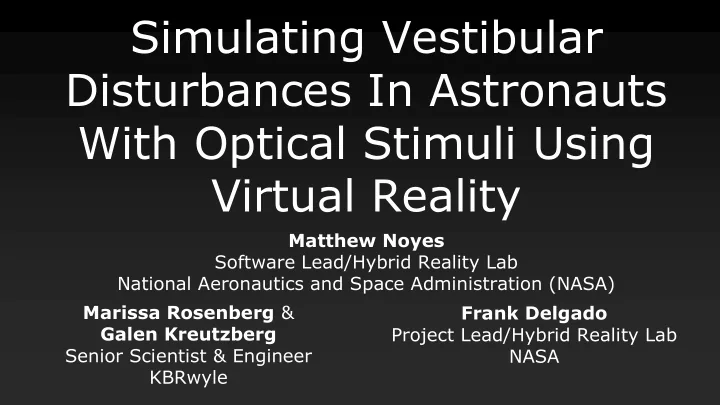

Simulating Vestibular Disturbances In Astronauts With Optical Stimuli Using Virtual Reality Matthew Noyes Software Lead/Hybrid Reality Lab National Aeronautics and Space Administration (NASA) Marissa Rosenberg & Frank Delgado Galen Kreutzberg Project Lead/Hybrid Reality Lab Senior Scientist & Engineer NASA KBRwyle
Hybrid Reality Virtual Real
INTRODUCTION • Astronauts perceive linear motion on head tilt
OpenStax College, Illustrations from Anatomy & Physiology, Connexions Web site. http://cnx.org/content/col11496/1.6/, Jun 19, 2013.
INTRODUCTION • Astronauts perceive linear motion on head tilt • Motion sickness/disorientation = egress risk • Water landings are especially dangerous • A sensorimotor countermeasure can lower risk
Can Hybrid Reality be a sensorimotor countermeasure?
STUDY OVERVIEW • 10 subjects (32.3 p/m 5.3 years, 5 males) • Each subject performed 4 sessions Martian Gravity Final Initial Acclimation Test Test Period Extra or Intra m G Vehicular Activity 0 15 30 Session Length (min)
STUDY OVERVIEW ARGOS Non-ARGOS A C D B
STUDY OVERVIEW ARGOS Non-ARGOS HRMP A C Non-HRMP D B
What is HRMP? Hybrid Reality-induced Motion • Perception Translating checkerboard pattern • tied to head rotation Creates vection •
STUDY OVERVIEW ARGOS Non-ARGOS HRMP A C Non-HRMP D B Phase 1: Microgravity Phase 2: Martian Gravity
Theoretical Basis Vision Brain Otolith Brain Stem Proprioception
Tools NVIDIA Falcor OpenVR OpenGL Fragment Shader
Tandem Walk Results Generalized Mixed Effects Model (binomial distribution, %correct) • Fixed Effects • Initial – Effect of the first trial without ARGOS, no HRMP, eyes open Eyes Closed – Effect of eyes closed without ARGOS, no HRMP, second trial HRMP – Effect of HRMP without ARGOS, the second trial, with eyes open ARGOS:Eyes Closed – Effect of ARGOS without HRMP with eyes closed on second trial ARGOS:HRMP – Effect of ARGOS with HRMP with eyes open on second trial HRMP:Eyes Closed – Effect of HRMP with eyes closed no ARGOS second trial
Effect on Tandem Walk Performance by Condition 2.5 Tandem Walk Effectiveness 2 1.5 Increasing 1 likelihood of 0.5 correct step 0 Decreasing -0.5 likelihood of correct step -1 Subjected Condition
Theoretical Basis Vision Brain Otolith Brain Stem Proprioception
Theoretical Basis HRMP Vision Brain Otolith Brain Stem Proprioception
Theoretical Basis HRMP Vision Brain Otolith Brain Stem Proprioception
Future Work 3D optical flow •
Future Work Improved Otolith model •
Future Work Eyetracking •
Future Work Hybrid Reality • Obstacle Course
Future Work On-Orbit Countermeasure •
Commercial Applications Senior Care • Neurological Disease • Blast-Related Traumatic Brain • Injury
Acknowledgments Marissa Rosenberg, Galen Kreutzberg, • Millard Reschke (JSC Neuroscience Lab) Zvi Greenstein & Anjul Patney (NVIDIA) • Adriel Arias (NASA) •
Thank You
NASA Hybrid Reality Lab Contacts Project Lead francisco.j.delgado@nasa.gov Software Lead matthew.noyes@nasa.gov
NASA Hybrid Reality Lab Contacts Project Lead francisco.j.delgado@nasa.gov Software Lead matthew.noyes@nasa.gov Questions
Recommend
More recommend